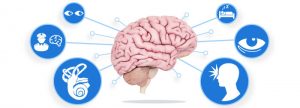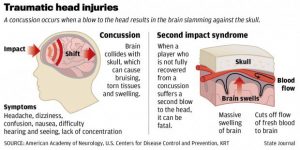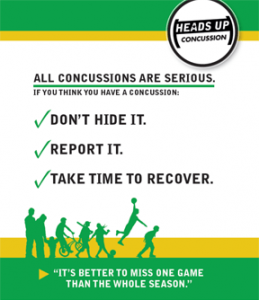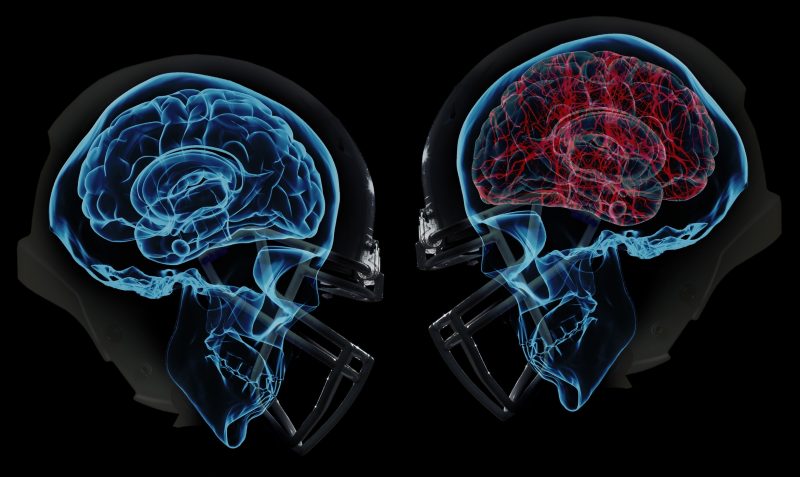1. It’s more than just a “simple hit” to the head
A concussion can occur from a traumatic brain injury that ultimately affects brain function. These effects are usually temporary but can include headaches, problems with concentration, memory loss, nausea, fatigue, and loss of coordination. What most people don’t understand is that while a concussion is usually caused by a hit to the head, the effects are extremely detrimental. You could even lose consciousness. A concussion is essentially causing injury to neural tissue and axons that are responsible for these symptoms. Moreover, concussions can impair higher-order brain functions through energy malfunction, inflammation, and even altered recycling, or degradation of proteins. So the next time you play football and get tackled to the ground or play a game of soccer and use your head to score the game-winning goal, think about the implications that this may have on your brain.
2. CTE
Chronic traumatic encephalopathy (CTE) is a serious brain disease that is characterized among individuals who have experienced a lot of trauma to their brain. Symptoms may not occur for CTE until years after the blow to the head, but can affect one’s mood, behavior, memory, and judgment. In essence, a protein, namely tau (also found in AD) is clumped and spread throughout brain tissue and destroys brain cells, as well. What is important to note in CTE is that it isn’t necessarily defined by a certain number of concussions, but rather a series of impacts to the head over a long period of time (even years) that could also likely not even be diagnosed as a concussion, but just a hard enough blow to the head.

3. Second impact syndrome
Second impact syndrome (SIS) is characterized by when an individual has recently had a head injury and another hit to the head is taken before the symptoms from the first hit have receded. SIS is often times deadly or can result in severe disability. This condition is extremely rare, but there exists very little research and data behind the condition because it is often hard to exactly define. Everyone’s mind is different and unique, and a concussion may affect people slightly different. This second hit to the head significantly decreases the brain’s ability to regulate itself due to cellular changes and increased ion fluxes, glutamate release, and other metabolic changes from the first concussion. This leads into the next point about athletes and returning to the game after a concussion.

4. Return to the game
Imagine you are the star player for your team and you just got taken out of the game because of a concussion. You feel a mix of emotions as you, yourself want to return to the game so badly-you have colleges coming to watch you play and need a scholarship to further your education. Your parents, friends, teammates, coaches all pressure you into a speedy recovery to get you back on the field. However, this could be extremely detrimental to your brain and a concussion should not be taken lightly. It is important to receive plenty of rest before returning to the game (however, avoid falling asleep immediately after a concussion as this could lead to death-discuss with your doctor), no matter how badly you might want to play, be honest about the symptoms you are having to the coach and healthcare professionals, and give your brain some time to heal.

5. New technology
As we live in the 21st century, there are some new, yet expensive, technologies that can help athletes out on the field. A Q-collar is a device that can be worn around the neck and works by compressing the jugular blood vessels in the neck for an increase of blood volume to the skull and brain. The ZERO1 helmet, now worn by some professional NFL players and college athletes will compress and twist in any direction from the angle of impact. Finally, new mouth guards have been invented to help with the concussion issue in sports. This mouth guard does not necessarily prevent a concussion from happening, but can send information such as the number, direction, and force of impact by sensors that are placed inside the device. This will hopefully provide a safer environment out on the field for athletes and allow the coaches to be notified when a diagnostic test for concussion should be ran.
Read more about Q-Collar here: https://www.sporttechie.com/q-collar-bauer-neuroshield-concussion-prevention-canada-brad-keselowski/
Read more about ZERO1 helmet here: https://vicis.com/products/zero1
Read more about new mouth guards here: https://www.fitguard.me

Now hopefully you know a few more tid-bits of information on concussions and whether you are an athlete or not, you likely know someone who has been impacted about a concussion. Go ahead and ask them: how long did you let your brain rest? Did you feel it was a long enough time? Have you had any other concussions since? These questions are vital to learning more about concussions!
Image 1: http://www.vereencenter.com/concussions-prevention-diagnosis-treatment/
Image 2: https://www.medbridgeeducation.com/blog/2016/04/concussions-and-symptom-variability/
Image 4: https://hilpischchiro.com/post-concussion-syndrome-natural-treatment-for-athletes-twin-cities/
Image 5: https://www.cdc.gov/headsup/basics/return_to_sports.html
